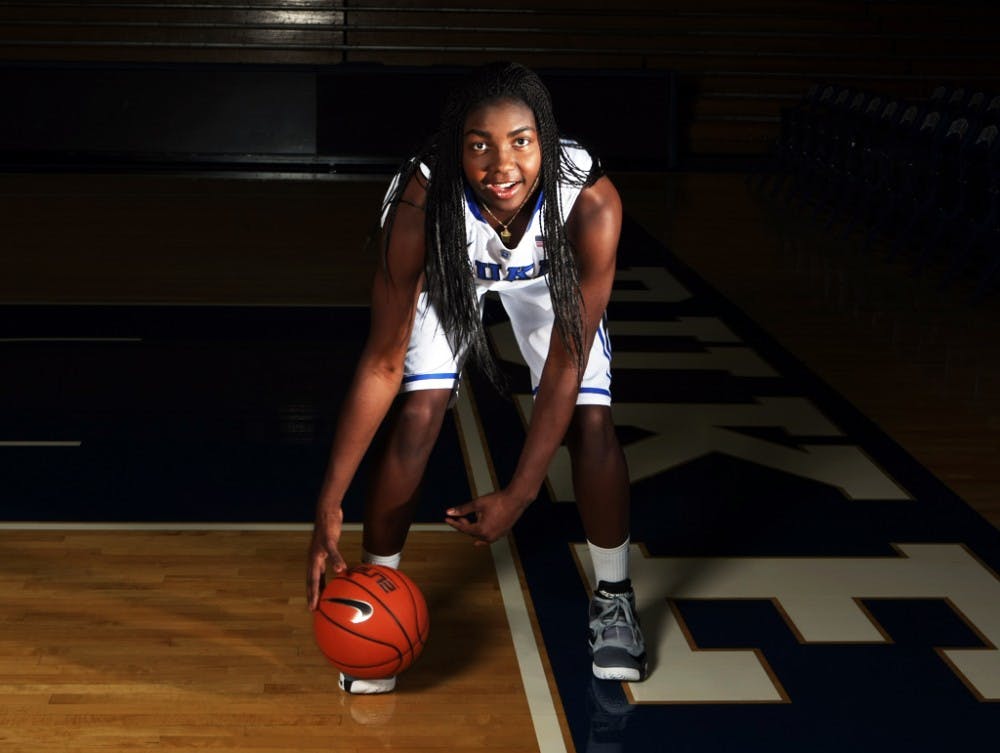After being decimated by injuries late last season, this year was supposed to be different for Duke. But with the season just beginning, the Blue Devils already face a daunting obstacle as preseason All-American Elizabeth Williams has not yet recovered from a stress fracture suffered last March.
The absence of Williams has put a damper on the high expectations for her and the rest of the team coming into the season. Returning four starters from a team that made the Elite Eight last year, expectations are high for head coach Joanne P. McCallie’s squad, earning the No. 3 ranking prior to the season. The Blue Devils are also the preseason favorites to win the ACC, but those rankings were contingent on the return of the 6-foot-3 sophomore, last year’s National Freshman of the Year.
A stress fracture occurs when there is an incomplete crack in the bone. The injury typically develops over time and occurs as extended practice and overuse places undue stress on the bone, eventually causing a small crack or fracture to develop.
In her first collegiate season, Williams averaged more than 30 minutes a game, the second-highest total on the team. This came on the heels of continuous practicing for more than a year between her senior year of high school and a summer playing for USA basketball, where she won a gold medal as a member of the 2011 U-19 team.
“I played USA basketball through the whole summer and once I got back I went straight into preseason,” Williams said. “I never rested my body for an extended period of time.”
All that time on the court finally caught up with Williams just before the NCAA Tournament when she was first diagnosed with the stress fracture in the tibia bone of her right leg, two days before the Big Dance began. Despite the pain, she elected to play through the injury and acquitted herself nicely, averaging 11.5 points and 28.3 minutes during the four games.
The primary treatment for stress fractures is extended rest. Relieving pressure off the bone is crucial for allowing the fracture to heal. In the offseason, Williams refrained from any basketball activity. She traveled with the team for their preseason trip to France and Italy, but did not participate in any of the games or practices. Williams used this time to get stronger and learn how to avoid placing as much pressure on her leg.
“I still lifted weights with the team, since I couldn’t do a lot of basketball stuff,” Williams said. “In rehab I did a lot of hip and ankle strengthening so that I wouldn’t be putting too much stress on my shin, and I would be able to learn how to use my hips more.”
Unfortunately for the Blue Devils, her recovery has not progressed as quickly as expected. The healing time for stress fractures can vary from four to 12 weeks, or even longer, but Williams with seven months since she first suffered the injury, her leg still has not completely healed.
“I’m day-to-day right now. Depending on my pain level is how much I’ll practice.” Williams said. “[It hurts] at points where I put a lot of pressure on it, jumping, if I lean to much in one step, things like that.”
The sophomore post player managed to play briefly in the team’s season-opening Blue-White scrimmage, but was limited to only 15 minutes. Even worse, after the team’s first exhibition game against Shaw, McCallie reported that the soreness in Williams’ leg had come back and she would be sidelined indefinitely.
“She’s been hurt and trying to strengthen that bone, but it keeps popping up,” McCallie said. “It’s been seven months since the stress fracture, and it would have been better if she had broke it.”
For now, the Blue Devils are resigned to withholding their star player from practice in hopes that her stress fracture will recover in time for conference play. Extended practice often triggers the pain, Williams said, while playing in games can be encouraging.
“It felt good playing, honestly,” Williams said in reference to the Blue-White scrimmage. “The pain usually comes if I play in practice for a couple of days in a row without rest and that’s when I start feeling the soreness.”
McCallie, however, did not sound optimistic about the benefits of more rest. “She gets oodles of rest. She hasn’t been through a full practice in over seven months,” McCallie said. “The key is I’ve got to be honest to Elizabeth. I can’t let her play at 40 percent.... She’s just got to simply see what she can do.”
If Williams’ stress fracture persists, the Blue Devils could be short on depth as they look to improve on their Elite Eight berths from the last three years—freshman forward Katie Heckmann is out for the year with an ACL injury while sophomores Chloe Wells and Richa Jackson are also battling injuries. So for now, the team’s late-season potential is just a distant for McCallie as she waits for her team to get healthy.
“Based on the injuries we’ve had, I just don’t think about that,” McCallie said. “We’ve got a starting five out. I realize how quickly things can change. These are all events outside of our control.”
Get The Chronicle straight to your inbox
Signup for our weekly newsletter. Cancel at any time.

